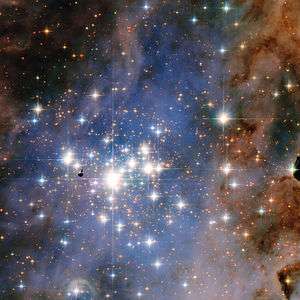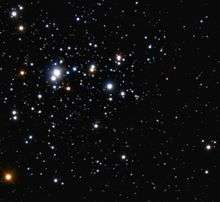HD 93129
HD 93129 is a triple star system in the Carina Nebula, with all three components being hot O class stars amongst the most luminous stars in the Milky Way. It is the dominant member of the Trumpler 14 star cluster, a young star cluster within the Carina OB1 stellar association that harbors other super-luminous stars, like Eta Carinae and WR 25.
 HD 93129 surrounded by the lesser stars of Trumpler 14 Credit: NASA & ESA, Jesús Maíz Apellániz (Instituto de Astrofisica de Andalucia) | |
| Observation data Epoch J2000 Equinox J2000 | |
|---|---|
| Constellation | Carina |
| Right ascension | 10h 43m 57.5s[1] |
| Declination | −59° 32′ 51.3″[1] |
| Apparent magnitude (V) | 6.90[2] (7.310[1] + 8.84[3]) |
| Characteristics | |
| A | |
| Spectral type | O2If*[4] (O2If+O3.5V[5]) |
| U−B color index | −0.81[3] |
| B−V color index | +0.25[3] |
| B | |
| Evolutionary stage | main sequence |
| Spectral type | O3.5 V((f))z[6] |
| U−B color index | −0.79[3] |
| B−V color index | +0.23[3] |
| Astrometry | |
| Radial velocity (Rv) | −0.4 ± 7.4[7] km/s |
| Proper motion (μ) | RA: -5.0[1] mas/yr Dec.: 17.0[1] mas/yr |
| Distance | 2,300[5] pc |
| Absolute magnitude (MV) | (A): −6.5 (−6.1 + −5.2) (B): −4.9[8] |
| Details | |
| Aa | |
| Mass | 110[8] M☉ |
| Radius | 22.5[9] R☉ |
| Luminosity | 1,480,000[10] L☉ |
| Surface gravity (log g) | 3.71[9] cgs |
| Temperature | 42,500[9] K |
| Rotational velocity (v sin i) | 130[9] km/s |
| Age | 0.9+0.2 −0.4[7] Myr |
| Ab | |
| Mass | 70[8] M☉ |
| Radius | 13.1[11] R☉ |
| Luminosity | 575,000[10] L☉ |
| Temperature | 44,000[11] K |
| B | |
| Mass | 52[12] M☉ |
| Radius | 13[12] R☉ |
| Luminosity | 575,000[10] L☉ |
| Surface gravity (log g) | 3.92[12] cgs |
| Temperature | 44,000[12] K |
| Rotational velocity (v sin i) | 112[7] km/s |
| Other designations | |
| A: TYC 8626-2805-1, ALS 15862, LS 1820 | |
| B: ALS 19309 | |
| Database references | |
| SIMBAD | HD 93129 |
| HD 93129 A | |
| HD 93129 B | |
Location
.jpg)
HD 93129 is found at the centre of the massive Trumpler 14 open cluster in the Carina Nebula star forming region. It is too far away for its distance to have been accurately determined using the annual parallax method, but accurate distances for η Carinae and the Homunculus Nebula, modelling of clusters, and astrophysical data about other stars assumed to be within the same region, all lead to a distance around 2,300 parsecs.[5] HD 93129 Aa is the closet O2 supergiant to Earth.[13]
That volume of space is home to many other massive and luminous stars. HD 93128, yet another O3.5 main sequence star, is only 24' away within Trumpler 14, and HD 93250 and HD 93205 are two more O3.5 stars in the larger Trumpler 16 cluster around η Carinae. There are also three Wolf-Rayet stars, an O4 supergiant, many other class O stars, and the unique η Carinae itself.[10]
System

HD 93129 consists of two clearly resolved components, HD 93129 A and HD 93129 B, and HD 93129 A itself is made up of two much closer stars.
HD 93129 A has been resolved into two components. The spectrum is dominated by the brighter component, although the secondary is only 0.9 magnitudes fainter. HD 93129 Aa is an O2 supergiant and Ab is an O3.5 main sequence star.[14] Their separation has decreased from 55 mas in 2004 to only 27 mas in 2013, but an accurate orbit is not available.[13]
HD 93129 B is an O3.5 main-sequence star 3 arc-seconds away from the closer pair. It is about 1.5 magnitudes fainter than the combined HD 93129 A, and approximately the same brightness as HD 93129 Ab.[1][3]
A further 5 fainter stars within 5 arc-seconds have been detected, between five and seven magnitudes fainter at infrared wavelengths.[13]
Properties
All three stars of HD 93129 are among the most luminous in the galaxy;[5] 1,480,000 L☉ for the supergiant primary and 575,000 L☉ for each of the other two stars. They are also among the hottest, with the supergiant at 42,500 K and the other two at 52,000 K. The stars have masses calculated to be between 70 M☉ and 110 M☉.
HD 93129Aa has left the main sequence and its age is estimated to be around 900,000 years. The existence of the zero-age main sequence stars within Trumpler 14 suggest its age may be less than 600,000 years.[7]
See also
References
- Høg, E.; Fabricius, C.; Makarov, V. V.; Urban, S.; Corbin, T.; Wycoff, G.; Bastian, U.; Schwekendiek, P.; Wicenec, A. (2000). "The Tycho-2 catalogue of the 2.5 million brightest stars". Astronomy and Astrophysics. 355: L27. Bibcode:2000A&A...355L..27H. doi:10.1888/0333750888/2862. ISBN 0333750888.
- Ducati, J. R. (2002). "VizieR Online Data Catalog: Catalogue of Stellar Photometry in Johnson's 11-color system". CDS/ADC Collection of Electronic Catalogues. 2237. Bibcode:2002yCat.2237....0D.
- Vazquez, R. A.; Baume, G.; Feinstein, A.; Prado, P. (1996). "Investigation on the region of the open cluster TR 14". Astronomy and Astrophysics Supplement. 116: 75. Bibcode:1996A&AS..116...75V.
- Sota, A.; Maíz Apellániz, J.; Morrell, N. I.; Barbá, R. H.; Walborn, N. R.; Gamen, R. C.; Arias, J. I.; Alfaro, E. J. (2014). "The Galactic O-Star Spectroscopic Survey (GOSSS). II. Bright Southern Stars". The Astrophysical Journal Supplement. 211: 10. arXiv:1312.6222. Bibcode:2014ApJS..211...10S. doi:10.1088/0067-0049/211/1/10.
- Cohen, D. H.; Gagné, M.; Leutenegger, M. A.; MacArthur, J. P.; Wollman, E. E.; Sundqvist, J. O.; Fullerton, A. W.; Owocki, S. P. (2011). "Chandra X-ray spectroscopy of the very early O supergiant HD 93129A: Constraints on wind shocks and the mass-loss rate". Monthly Notices of the Royal Astronomical Society. 415 (4): 3354–3364. arXiv:1104.4786. Bibcode:2011MNRAS.415.3354C. doi:10.1111/j.1365-2966.2011.18952.x.
- Maíz Apellániz, J.; Sota, A.; Arias, J. I.; Barbá, R. H.; Walborn, N. R.; Simón-Díaz, S.; Negueruela, I.; Marco, A.; Leão, J. R. S.; Herrero, A.; Gamen, R. C.; Alfaro, E. J. (2016). "The Galactic O-Star Spectroscopic Survey (GOSSS). III. 142 Additional O-type Systems". The Astrophysical Journal Supplement Series. 224: 4. arXiv:1602.01336. Bibcode:2016ApJS..224....4M. doi:10.3847/0067-0049/224/1/4.
- Penny, Laura R.; Gies, Douglas R.; Hartkopf, William I.; Mason, Brian D.; Turner, Nils H. (1993). "The frequency of binary stars in the young cluster Trumpler 14". Publications of the Astronomical Society of the Pacific. 105: 588. Bibcode:1993PASP..105..588P. doi:10.1086/133200.
- Nelan, Edmund P.; Walborn, Nolan R.; Wallace, Debra J.; Moffat, Anthony F. J.; Makidon, Russell B.; Gies, Douglas R.; Panagia, Nino (2004). "Resolving OB Systems in the Carina Nebula with the Hubble Space Telescope Fine Guidance Sensor". The Astronomical Journal. 128: 323–329. Bibcode:2004AJ....128..323N. doi:10.1086/420716.
- Repolust, T.; Puls, J.; Herrero, A. (2004). "Stellar and wind parameters of Galactic O-stars. The influence of line-blocking/blanketing". Astronomy and Astrophysics. 415: 349–376. Bibcode:2004A&A...415..349R. doi:10.1051/0004-6361:20034594.
- Smith, Nathan (2006). "A census of the Carina Nebula - I. Cumulative energy input from massive stars". Monthly Notices of the Royal Astronomical Society. 367 (2): 763–772. arXiv:astro-ph/0601060. Bibcode:2006MNRAS.367..763S. doi:10.1111/j.1365-2966.2006.10007.x.
- Del Palacio, Santiago; Bosch-Ramon, Valentí; Romero, Gustavo E.; Benaglia, Paula (2016). "A model for the non-thermal emission of the very massive colliding-wind binary HD 93129A". Astronomy & Astrophysics. 591: A139. arXiv:1604.07294. Bibcode:2016A&A...591A.139D. doi:10.1051/0004-6361/201628264.
- Vink, Jorick S; Davies, B; Harries, T. J; Oudmaijer, R. D; Walborn, N. R (2009). "On the presence and absence of disks around O-type stars". Astronomy and Astrophysics. 505 (2): 743. arXiv:0909.0888. Bibcode:2009A&A...505..743V. doi:10.1051/0004-6361/200912610.
- Sana, H.; Le Bouquin, J.-B.; Lacour, S.; Berger, J.-P.; Duvert, G.; Gauchet, L.; Norris, B.; Olofsson, J.; Pickel, D.; Zins, G.; Absil, O.; De Koter, A.; Kratter, K.; Schnurr, O.; Zinnecker, H. (2014). "Southern Massive Stars at High Angular Resolution: Observational Campaign and Companion Detection". The Astrophysical Journal Supplement. 215: 15. arXiv:1409.6304. Bibcode:2014ApJS..215...15S. doi:10.1088/0067-0049/215/1/15.
- Benaglia, P.; Koribalski, B. (2004). "Radio observations of HD 93129A: The earliest O star with the highest mass loss?". Astronomy & Astrophysics. 416 (1): 171–178. arXiv:astro-ph/0312003. Bibcode:2004A&A...416..171B. doi:10.1051/0004-6361:20034138.